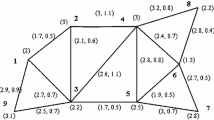Abstract
This paper presents the problem of scheduling security teams to patrol a mass rapid transit rail network of a large urban city. The main objective of patrol scheduling is to deploy security teams to stations of the network at varying time periods subject to rostering as well as security-related constraints. We present several mathematical programming models for different variants of this problem. To generate randomized schedules on a regular basis, we propose injecting randomness by varying the start time and break time for each team as well as varying the visit frequency and visit time for each station according to their reported vulnerability. Finally, we present results for the case of Singapore mass rapid transit rail network and synthetic instances.







Similar content being viewed by others
Notes
Note that the team 2 in Table 4 serves two lines: the horizontal line (S10 S8 S7) and the circle line (S7 S17 S16 S15). However, this situation is not counted as changing lines, since both the trip from S8 to S7 and the trip from S7 to S17 are traveled on only one line.
The two random instances Random1 and Random2 are not considered for the studies hereafter due to the unavailability of population data.
References
Babu, V. L. L., Batta, R., & Li, L. (2006). Passenger grouping under constant threat possibility in an airport security system. European Journal of Operational Research, 168(2), 633–644.
Basar, T., & Olsder, G. J. (1995). Dynamic noncooperative game theory. London: Academic Press.
Chu, S. C., & Chan, E. C. (1998). Crew scheduling of light rail transit in Hong Kong: From modeling to implementation. Computers & Operations Research, 25(11), 887–894.
Curtin, K. M., McCall, K. H., & Qiu, F. (2010). Determining optimal police patrol areas with maximal covering and backup covering location models. Networks and Spatial Economics, 10(1), 125–145.
Elizondo, R., Parada, V., Pradenas, L., & Artigues, C. (2010). An evolutionary and constructive approach to a crew scheduling problem in underground passenger transport. Journal of Heuristics, 16(4), 575–591.
Ernst, A. T., Jiang, H., Krishnamoorthy, M., & Sier, D. (2004). Staff scheduling and rostering: A review of applications, methods and models. European Journal of Operational Research, 153(1), 3–27.
Gunawan, A., & Lau, H. C. (2013). Master physician scheduling problem. Journal of the Operational Research Society, 64(3), 410–425.
Jain, M., Tsai, J., Pita, J., Kiekintveld, C., Rathi, S., Tambe, M., et al. (2010). Software assistants for randomized patrol planning for the lax airport police and the federal air marshals service. Interfaces, 40(4), 267–290.
Jiang, A.X., Yin, Z., Kietkintveld, C., Leyton-Brown, K., Sandholm, T., & Tambe, M. (2012). Towards optimal patrol strategies for fare inspection in transit systems. In AAAI spring symposium on game theory for security, sustainability and health.
Maenhout, B., & Vanhoucke, M. (2010). A hybrid scatter search heuristic for personalized crew rostering in the airline industry. European Journal of Operational Research, 206(1), 155–167.
Ordóñez, F., Tambe, M., Jara, J. F., Jain, M., Kiekintveld, C., & Tsai, J. (2013). Handbook of operations research for homeland security. International series in operations research & management science (Vol. 183, pp. 45–72).
Petrovic, S., & Berghe, G. V. (2008). Comparison of algorithms for nurse rostering problems. In Procedings of the 7th international conference on the practice and theory of automated timetabling (pp. 1–18).
Rosenshine, M. (1970). Contributions to a theory of patrol scheduling. Operational Research Quarterly, 21(1), 99–106.
Sharma, D. K., Ghosh, D., & Gaur, A. (2007). Lexicographic goal programming model for police patrol cars deployment in metropolitan cities. International Journal of Information and Management Sciences, 18(2), 173–188.
Sinuany-Stern, Z., & Teomi, Y. (1986). Multi-objective scheduling plans for security guards. Journal of the Operational Research Society, 37, 67–77.
Taylor, P. E., & Huxley, S. J. (1989). A break from tradition for the san francisco police: Patrol officer scheduling using an optimization-based decision support system. Interfaces, 19(1), 4–24.
Tsai, J., Kiekintveld, C., Ordóñez, F., Tambe, M., & Rathi, S. (2009). Iris-a tool for strategic security allocation in transportation networks. In Proceedings of the 8th international conference on autonomous agents and multiagent systems (pp. 37–44).
Varakantham, P., Lau, H. C., & Yuan, Z. (2013). Scalable randomized patrolling for securing rapid transit networks. In Twenty fifth annual conference on innovative applications of artificial intelligence (IAAI).
Zhang, Y., & Brown, D. E. (2013). Police patrol districting method and simulation evaluation using agent-based model & gis. Security Informatics, 2(7), 1–13.
Author information
Authors and Affiliations
Corresponding author
Rights and permissions
About this article
Cite this article
Lau, H.C., Yuan, Z. & Gunawan, A. Patrol scheduling in urban rail network. Ann Oper Res 239, 317–342 (2016). https://doi.org/10.1007/s10479-014-1648-9
Published:
Issue Date:
DOI: https://doi.org/10.1007/s10479-014-1648-9




